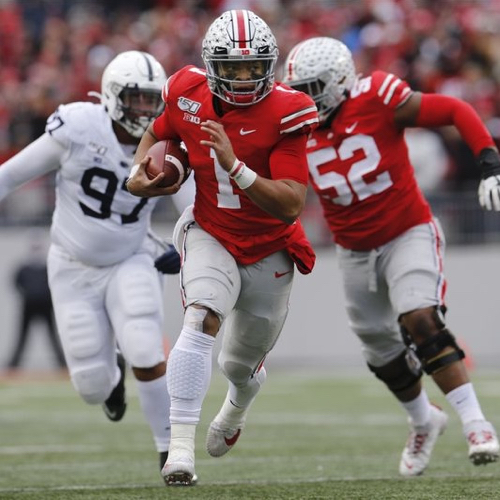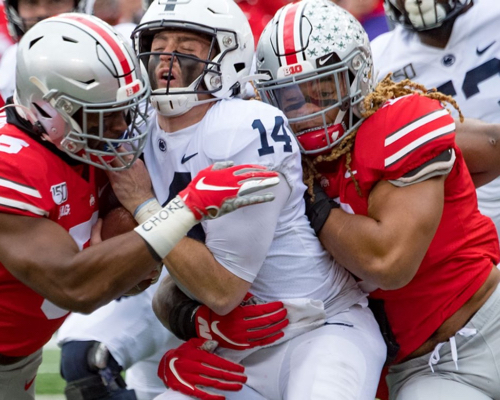Ohio State loses turnover battle, 3-1, but manages to pull out 28-17 win … Dobbins has big day against stout Penn State defense … Fields gets job done as Buckeyes run record to 11-0.
COLUMBUS — We can quibble all day about how feeble Ohio State looked for much of the second half.
We can question some of the conservative play-calling at various stages when receivers were often running free.
We can wonder if the turnover-prone Buckeyes are playoff-ready — or even if they have what it takes to beat Michigan next week — after letting Penn State get so close that some of the 104,355 fans probably left their seats to pace around the Ohio Stadium concourse while gnawing their fingernails to the nubs.
But if the inhabitants of Buckeye Land can’t savor a 28-17 win over the nation’s eighth-ranked team that clinched a third-straight Big Ten East crown, guaranteeing a spot in the league title game regardless of what happens in Ann Arbor, then they’re hereby sentenced to transfer their allegiance to another team for one entire year. Say, UMass.
No. 2 Ohio State overcame three ill-timed fumbles — do those things ever occur at optimal times in big games? — and prevailed, 28-17, to hike its record to a sparkling 11-0 on Senior Day.
Though commentators may hesitate now to label them a postseason lock, the Buckeyes showed they can handle themselves in an excruciatingly close, tension-stuffed game against a top-notch foe, which could come in handy down the road.

Sheward-Fulks Insurance, in Jackson, is a proud sponsor of Buckeyes sports on Press Pros Magazine.com.
After K.J. Hill scored on a 24-yard catch on the first possession of the second half, the Buckeyes had a 330-64 edge in total yards.
They led, 21-0, and it could have been worse. In all six of their drives to that point, they reached at least the Penn State 36-yard line.
A three-touchdown lead, though, figured to be enough. The only way anyone could conceivably imagine the Nittany Lions scoring 21 points, barring a sudden rule change that allowed skill players to wear jet-packs, was if they got major help from the Buckeyes.

Justin Fields was 16 of 22 passing for 188 yards and two scores.
And they did.
Freshman QB Will Levis, who had a combined 31 passes and rushes going into the game, replaced injured starter Sean Clifford midway through the third quarter, and the Penn State offense suddenly showed a pulse.
Journey Brown broke tackles and scored on an 18-yard run. On the Buckeyes’ first snap after that, J.K. Dobbins fumbled, and Penn State recovered at the 12 and scored in two plays.
Ohio State started moving, but Justin Fields then coughed it up — or did he? He looked as if he had a knee down before being stripped, but, if we’ve learned nothing else as sports fans, you know you can never trust replay officials to get it right.
Penn State ball.
A field goal made it 21-17 with 4:22 left in the third quarter, giving the Nittany Lions 17 points in three minutes and 17 seconds.
Gut-check time.
After one empty possession, the Buckeyes scored on Fields’ 28-yard pass to Chris Olave, who made a sensational catch near the end-zone boundary in traffic, making it 28-17 early in the fourth quarter.
It wasn’t over, though, until linebacker Justin Hilliard intercepted a dump pass over the middle with 10:16 left.
“From the beginning to the end, you couldn’t take a deep breath at all. You felt like you were holding your breath for 60 minutes,” first-year coach Ryan Day said.
“One of the things about a game like this, you’ve got to be willing to take punches. You have to not flinch when it happens. … We were reeling right there. We had to respond. Our backs were to the wall. And we did. To win a game like that, which was not clean, shows the toughness we have.”
Chase Young solidified his place as the top NFL draft prospect, flying in for three sacks. He blew past Vernon Gholston’s 2007 school-record of 14 sacks, climbing to 16.5 this season.
But the disruptive defensive end had help. Linebacker Baron Browning was back after dealing with injuries for several weeks, and he was another heat-seeking missile. He had 2.5 tackles for loss, including 1.5 sacks.

Bowlerstore.com, in Versailles, Ohio, is a proud sponsor of the Buckeyes on Press Pros Magazine.com.
The defense may have looked vulnerable at times, but let’s not forget that mistakes had given the Nittany Lions short fields. The unit allowed only 227 total yards, and the visitors didn’t come close to scoring after their third-quarter flurry.
The Buckeyes’ ability to run the ball was crucial, too, even if it wasn’t always a work of art. Dobbins rushed for 157 yards and two TDs on 36 carries (a 4.4 average), while Fields had 96 yards on 18 totes (a 5.3 average), not counting sacks.
They went 91 yards for a TD on their opening possession without completing a pass. And if they can run on Penn State and its vaunted front seven, they probably can run on anyone.
Fields was 16 of 22 passing for 188 yards and two scores. But Day, known for his cutting-edge offense, mostly kept the aerial attack in the hangar.
“It was a little hectic. We were turning the ball over. Our defense was playing strong. I said to the guys, ‘We’re going to keep trying to be aggressive, but we need to eat up some clock and get some first downs,’” Day said.
“If we had a little more rhythm, we’d be throwing the ball downfield and being more aggressive. I just felt we needed to shorten the game — and that’s not easy to do for an offensive guy.”
PLAYOFF SCENARIO: Some may suggest the Buckeyes can afford a close loss to Michigan, as long as they win the Big Ten title by beating either Wisconsin or Minnesota. But that puts them in a pool of other one-loss contenders, and I wouldn’t like their chances if the committee has to pick between them and a second SEC team.

Chase Young solidified his place as the top NFL draft prospect, flying in for three sacks.
Can you imagine, though, if the Buckeyes, as dominant as they’ve been all year, lose once and get left out of the playoffs for a third straight year as a league champ? That’s why a four-team playoff isn’t enough.
That’s four out of 130 Division-I teams. That’s four when you have five major conferences. That’s four with Notre Dame lurking and potentially taking a spot.
That means 3 percent of the field advances.
In Division III, 32 teams make the postseason out of 250 schools. That’s 12.8 percent.
The FCS has a 24-team playoff for 126 teams. That’s 19 percent. And if player safety is supposedly a concern at the top level, why isn’t it the same for the next tier down?
The pros are even more accommodating. Sixteen of 30 NBA teams, 10 of 30 MLB clubs (that’s 30 if you count the Reds … sorry) and 12 of 32 NFL teams make the playoffs. Yes, there are more business considerations at that level, but college football fans are no less passionate.
I understand the argument that eight teams will diminish the bowls, but I don’t buy it. Or that it will lessen the importance of the regular-season, but that’s a fallacy, too.
If you play the quarterfinals at campus sites and give the top four teams home games, the fight for those four seeds will be fierce, and we’ll still have the usual season-long debates.
As for the bowls, they’ve already been diminished by the playoffs. An extra round at home sites in December won’t change anything.
Think about it: the Big Ten-winning Buckeyes played Southern Cal in the Cotton Bowl two years ago and Washington in the Rose Bowl last season. Did either game generate even an ounce of buzz? Seemed like snoozers to me.
That’s how much the playoffs dwarf everything in college football.
The major bowls had a nice run, but they’re never going to regain their stature.
This is where we are. Let’s just accept it.

Ohio State running back J.K. Dobbins, right, cuts up field against Penn State defensive back Lamont Wade during the first half. (File Photos)

